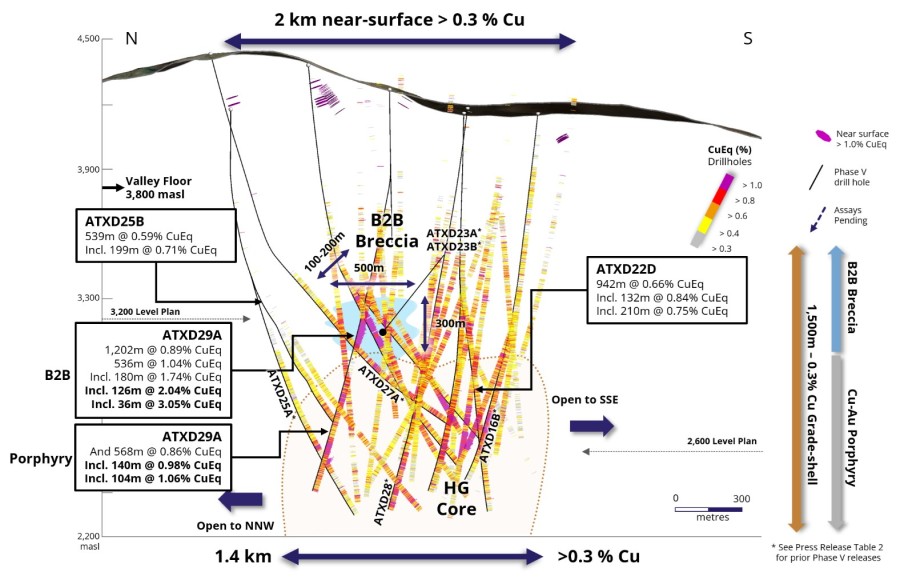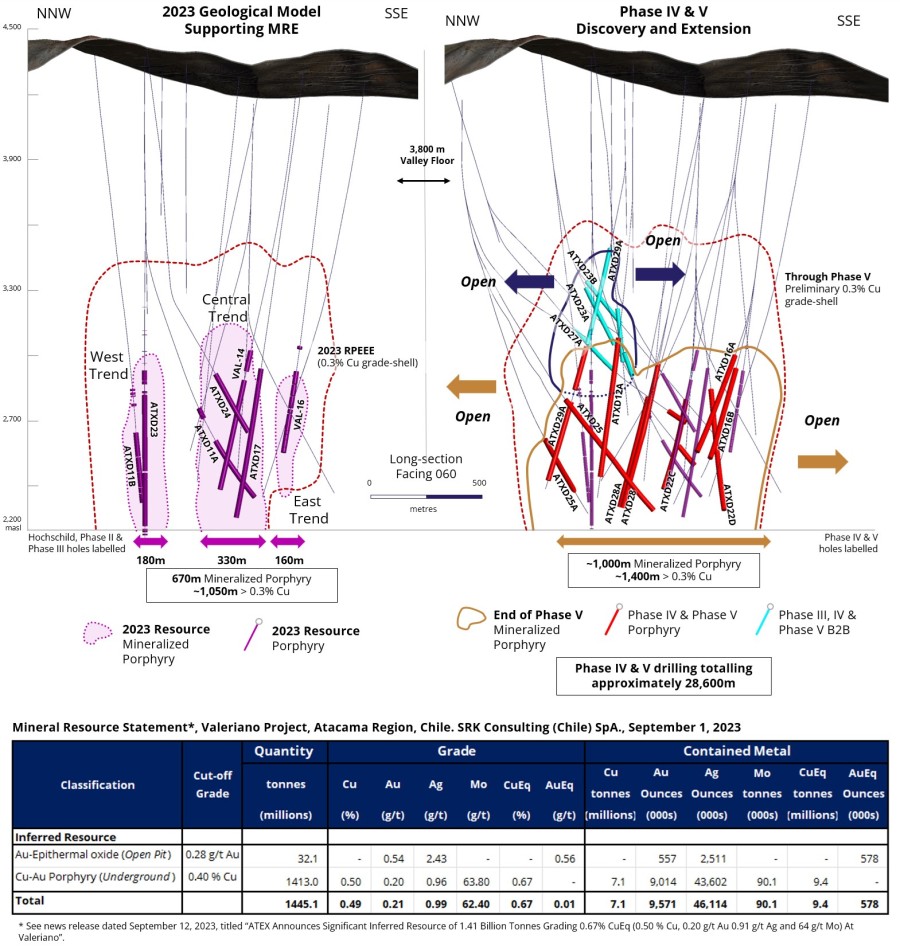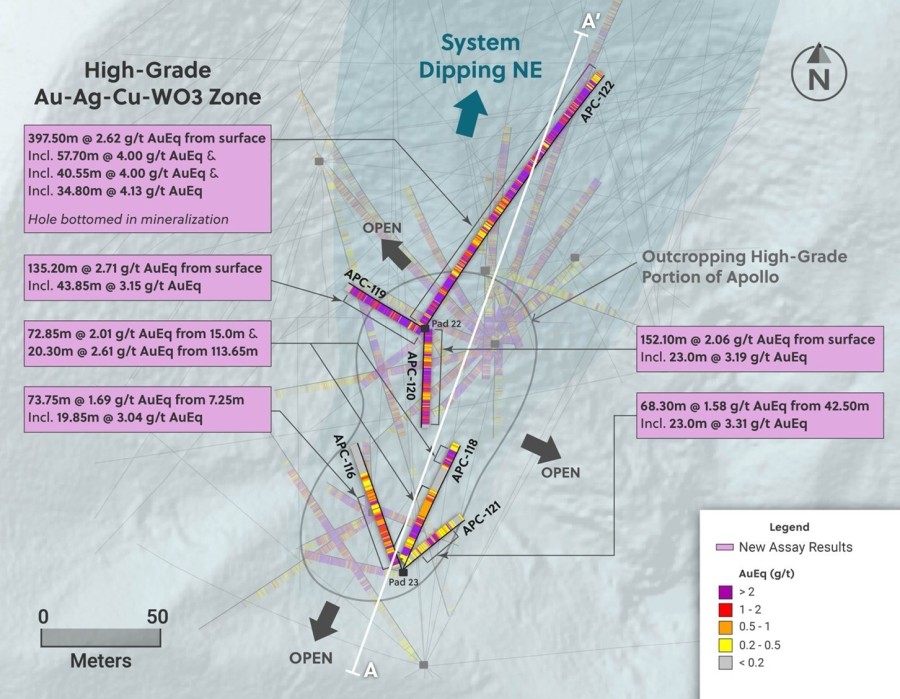VANCOUVER, Jan. 10, 2018 /CNW/ - Trilogy Metals Inc. (TSX/NYSE American: TMQ) ("Trilogy Metals" or the "Company") is pleased to provide an update on metallurgical test work results for samples from the In-Pit Resource area of the Bornite Project, a part of the Company's Upper Kobuk Mineral Projects ("UKMP") located in the Ambler mining district of Northwest Alaska. The defined In-Pit Resource contains 40.5 Mt of 1.02% Cu (indicated) and 84.1 Mt Cu (inferred) at 0.5% Cu cut-off grade. The objectives of this test work are to demonstrate that the Bornite mineralized materials are amenable to the production of high-grade copper concentrates using traditional mineral processing techniques and to determine the hardness and grindability of the mineralization. Results demonstrate that a high quality, 30% copper concentrate containing no deleterious metals can be produced. Furthermore, grindability test work conducted indicates an average Bond Work Index of 9.8kWhr/tonne, which is considered soft and therefore will have low grinding costs and power consumption. Test work has been completed at SGS Laboratories in Burnaby, British Columbia, which is independent of Trilogy Metals. Test work followed industry standard methods and procedures commonly used for the design and development of copper recovery processes, including hardness testing, floatation testing (lock cycle testing) and assaying of metallurgical products.
Two HQ diamond drill holes were drilled in the Bornite deposit, specifically to obtain representative material for use in metallurgical testing. Five main metallurgical composites were prepared from whole core obtained from this drilling and the composite samples are outlined in Table 1.
Table 1 – Composite Samples
|
Composite Name |
Drill Hole and Metres |
Cu |
Fe |
Co |
S |
|
% |
% |
% |
% |
||
|
Composite 1 |
RC13-02321, 6.5m - 69.7m |
1.11 |
7.72 |
0.02 |
8.29 |
|
Composite 2 |
RC13-0232, 69.7m -137.2m |
0.91 |
5.97 |
0.02 |
4.78 |
|
Composite 3 |
RC13-02302, 0.5m – 56.9m |
0.96 |
6.01 |
0.02 |
4.99 |
|
Composite 4 |
RC13-0230, 118.2m - 179.5m |
1.45 |
10.4 |
0.03 |
11.6 |
|
Composite 5 |
RC13-0230, 179.5m – 249.5m |
1.02 |
9.12 |
0.02 |
10.2 |
|
1RC13-0232 was drilled due north at an angle of -60°. |
|
2RC13-0230 was drilled due south at an angle of -77° from the same pad as RC13-0232. |
The Bornite deposit is hosted in dolomite and typically contains approximately 5 to 15 percent total sulphide minerals including pyrite, chalcopyrite, bornite and chalcocite. Mineralogical evaluations conducted as part of this test work program show the copper minerals to display a wide variety of grain sizes. A majority of the copper mineralization is very well liberated at 100 microns, however, a minor fraction of the contained copper consists as very fine-grained copper sulphide minerals occurring in pyrite (5 to 15 percent of the overall copper). The copper rich zones of the Bornite deposit do not typically contain significant precious metals and nor do the concentrates. Penalty elements in both the mineralized materials and copper concentrates are also low and below levels of concern.
The mineralized materials were subject to grindability testing to determine power requirements in grinding. The materials were shown to be consistent with an average work index determination (Bond Work Index) of 9.8kWhr/tonne. Of the 15 individual samples tested, the variance of work indices was very low, with a minimum value of 8.8kWhr/tonne and a maximum value of 10.8kWhr/tonne. The Bornite materials are considered soft to very soft in terms of grinding power requirements.
The production of copper concentrates from the Bornite materials is based on traditional grinding and flotation processes and a flowsheet is shown in Figure 1. Unit operations in this flowsheet include crushing, grinding to approximately 100 microns, rough flotation concentrate production, rough concentrate re-grinding (10-15 microns) and flotation cleaning.

The expected metallurgical performance of the test samples is summarized in the following Table 2 and is based on locked cycle testing of the flowsheet shown in Figure 1. These results are obtained with a consistent set of metallurgical parameters across all test samples and are considered a significant improvement over previous test results for the deposit.
Table 2 - Summary of Expected Metallurgical Performance - Bornite Composite Samples
|
Composite Name |
Cu Feed Grade |
Copper Recovery |
Copper Conc. Grade |
|
% Cu |
% |
% Cu |
|
|
Composite 1 |
1.11 |
90.4 |
30.3 |
|
Composite 2 |
0.91 |
87.0 |
24.3 |
|
Composite 3 |
0.96 |
89.7 |
25.6 |
|
Composite 4 |
1.45 |
91.6 |
33.5 |
|
Composite 5 |
1.02 |
90.9 |
28.0 |
Future metallurgical test work planned for the Bornite include an evaluation of the potential to recover cobalt from zones which are shown to be high in cobalt. Additional copper recovery test work will cover a broader range of grades (0.2% to 2%) and continue to be focused on the flowsheet and processing philosophy shown in Figure 1.
Rick Van Nieuwenhuyse, President and CEO of Trilogy Metals commented, "The metallurgical results reported here continue to demonstrate that we can produce a high quality copper concentrates of 24% to 33% containing no deleterious metals. The soft work index means grinding and power costs will be low relative to more traditional sources of copper from harder porphyry deposits. We are also excited to continue work on the cobalt. Cobalt occurs as carrolite and cobaltiferous pyrite. Electron microprobe and metallurgical work will be conducted during the winter months with the objective of determining if the cobalt can be concentrated into a saleable product. If it is determined that it can, then cobalt will be added to the resource base as a potentially valuable metal which could enhance the value of the possible Bornite ores".
Qualified Persons
The metallurgical information in this news release has been prepared in accordance with Canadian regulatory requirements set out in National Instrument 43-101 Standards of Disclosure for Mineral Projects of the Canadian Securities Administrators ("NI 43-101") and supervised, reviewed and verified by Jeffrey B. Austin, P.Eng., President, of International Metallurgical and Environmental Inc., a "Qualified Person" as defined in National Instrument 43-101 and the person who oversees metallurgical developments for Trilogy Metals.
About Trilogy Metals
Trilogy Metals Inc. is a metals exploration company focused on exploring and developing the Ambler mining district located in northwestern Alaska. It is one of the richest and most- prospective known copper-dominant districts located in one of the safest geopolitical jurisdictions in the world. It hosts world-class polymetallic VMS deposits that contain copper, zinc, lead, gold and silver, and carbonate replacement deposits which have been found to host high grade copper mineralization. Exploration efforts have been focused on two deposits in the Ambler mining district - the Arctic VMS deposit and the Bornite carbonate replacement deposit. Both deposits are located within the Company's land package that spans approximately 143,000 hectares. The Company has an agreement with NANA Regional Corporation, Inc., a Regional Alaska Native Corporation that provides a framework for the exploration and potential development of the Ambler mining district in cooperation with local communities. Our vision is to develop the Ambler mining district into a premier North American copper producer.





